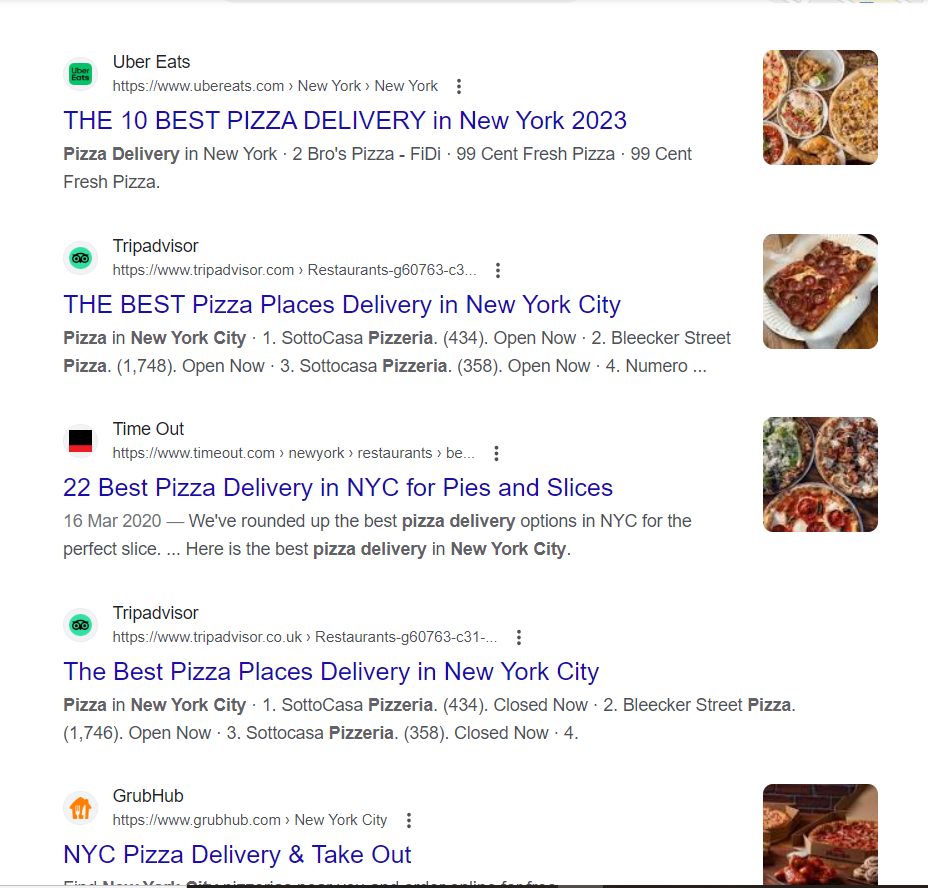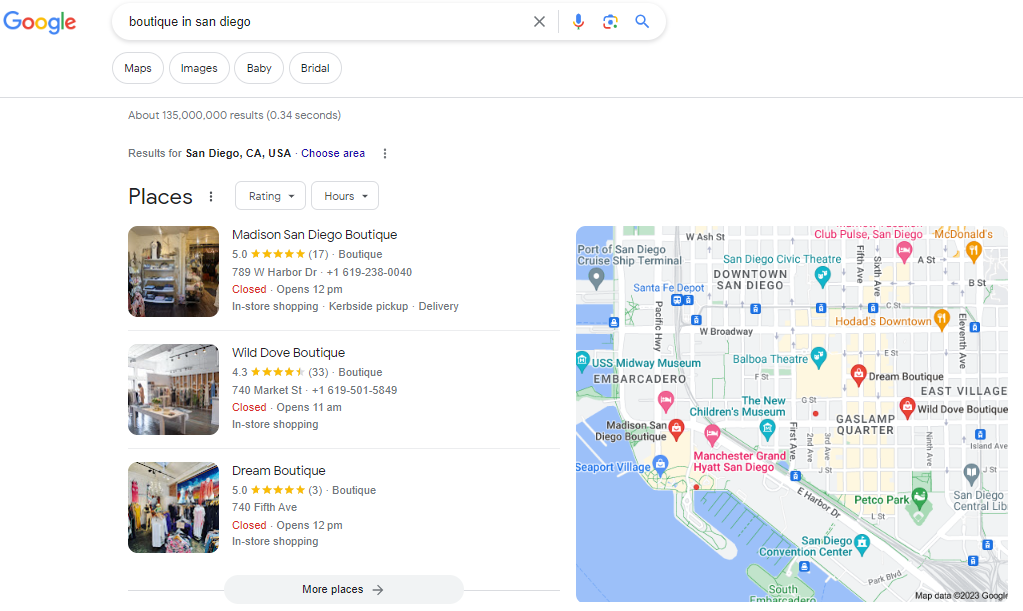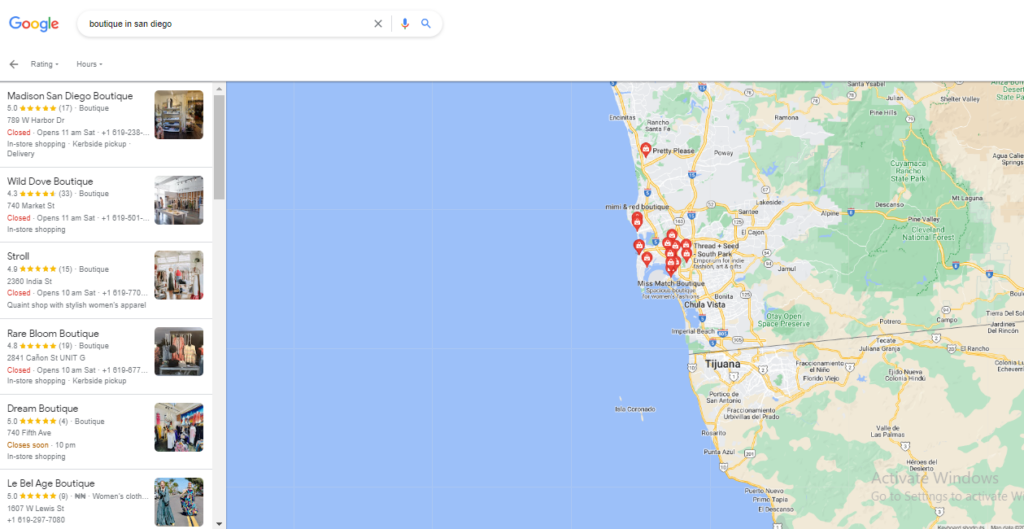The reliance on local searches shows why most businesses strive to build real estate on local SERPs. However, it’s not easy. Most businesses struggle to crack the algorithm and have an edge on local SERPs.
This article will provide a basic understanding of local SERPs, the key differences between local SEO and organic “normal” SEO, how the algorithm works differently, and how to build a solid organic presence on Local SERPs.
What is Local SEO?
Local SEO optimizes a website or online presence to improve its visibility in local search results. It is essential for businesses with physical locations serving customers in particular cities, regions, or regions.
Local SEO aims to make a business more visible to local customers when searching for products, services, or information related to their niche. By implementing effective local SEO strategies, your business can improve its online visibility, attract more local customers, and increase its chances of being found in local search results.
What is Google Local SERP?
Google Local Search Engine Results Pages (SERPs) refer to search results pages displayed by Google for local search queries. When users enter search queries with local intent, such as searching for products or services in a specific geographic location, Google provides a localized search results page called the Local SERP. This page includes local business listings, maps, and organic search results.
Local SEO Versus “Traditional” SEO
Google processes over eight million searches daily but provides unique result pages to all of them.
Let’s examine a few of them:
1. Target Audience
Local SEO optimizes a website’s online presence to attract customers in a specific geographical area. The goal is to improve visibility for location-based searches.
Local SEO is particularly relevant for businesses serving customers in a specific city, region, or location. For example, a local bakery or a dental clinic would benefit from local SEO to reach customers nearby.
Organic SEO aims to improve a website’s visibility in search engine results for relevant keywords and topics, regardless of the user’s location. The target audience is not limited to a specific location but can be anyone searching for information, products, or services related to the website’s niche.
2. Search Intent
Local SEO targets search queries with local intent. It aims to provide relevant results to a specific location, such as “restaurants near me” or “flower boutiques in Chicago.”
On the other hand, organic SEO focuses on search queries that are not location-specific and can cover a broader range of topics or industries.
3. Citations Versus Links
In local SEO, citations are vital for ranking, visibility, and authority. They are online references; essentially mentions of your business’ NAP on online directories. Citations validate your business’ existence and give you chances to come up in searches related to your business.
Backlinks are a crucial ranking factor in organic search engine result pages. You increase your website’s relevance and authenticity with search engines by building your website’s backlink profile.
Let’s delve a bit by exploring how Google’s algorithm determines the pages it displays on normal organic search results.
Factors That Help Determine Normal Organic Search Engine Rankings
With large volumes of content being published daily, it can be challenging to decipher between the wheat and the grains. That’s why Google’s ranking systems help users scale through the hurdle of finding what they need.
The ranking process works in a fraction of a second – the algorithm sorts through the Search index and provides web pages relevant to the user’s query.
However, Google’s algorithm considers five factors before it returns any result for its users:
- Meaning
- Relevance
- Quality
- Usability
- Context
1. Meaning of the Query
The first step is understanding the intent behind users’ queries. To do this, Google built language models that match your search query with the most helpful content available.
The language models perform essential functions like correcting spelling mistakes and extend to the synonym system, which helps the algorithm match relevant content even though the query doesn’t contain the exact word. For example, if you search “how to fix my laptop screen,” the manufacturer may use “how to repair my laptop screen.” The system understands the words and automatically matches the suitable content.
Also, if you search for trending keywords like the current wave of AI, the algorithm knows that you need up-to-date information rather than showing older web pages.
2. Relevance of the Content
Google’s primary goal is to provide its users with the most relevant information based on their search queries. This is why the algorithm helps to provide the most suitable content based on a searcher’s query.
The primary signal that a page is relevant for a search term is if it contains the same keyword in the query. If the keyword in the user’s search term appears in the headings or body of the content, it’s most likely to be relevant.
Beyond keyword match, the system also uses aggregated and anonymized interaction data. For example, if you search for “cars,” you don’t want a page with the word “cars” on it several times – that’s keyword stuffing which can make you pissed off halfway. That’s why the algorithm checks if a page contains other relevant content beyond the word “cars.” Content like videos of cars, pictures of cars, and more.
3. Quality of Content
After identifying content relevance, the next step is to shuffle pages based on content quality. The goal is to provide web pages with content that demonstrates experience, expertise, authoritativeness, and trustworthiness. You can read the E-E-A-T update for more understanding.
A promising sign the algorithm uses to vet this factor is analyzing if other reputable sites link to the content. Over time, it’s a valid proof of content quality and authoritativeness.
4. Web Pages Usability
After considering the content on the page, the algorithm checks the page’s usability, i.e., the system analyzes the page experience aspects. The system checks the page speed and other factors like mobile-friendliness.
5. Context and Setting
Google algorithm considers your location, past search history, and search setting to determine which results are returned for your query.
For example, when a user searches for “restaurants near me,” the algorithm uses their current location (determined by their device’s GPS or IP address) to provide a list of restaurants in their immediate area.
Search settings are also crucial in determining the result displayed for your search queries. For example, if you set up a preferred language, your result pages will be based on your setting.
How Google Determines Local Search Results
Google utilizes a complex algorithm to determine the most relevant and applicable local search results for users. The algorithm takes into account various factors to deliver personalized and location-specific results.
Local search results depend on three crucial factors: relevance, distance, and prominence. The blend of these three key factors determines your business’s ranking in search results.
Let’s discuss these three factors in detail:
- Relevance: how does your business profile match the customer’s intent? Google will assess the relevance of your business to a user’s search query by considering factors such as the content on your business website, the categories associated with the business, and the keywords used in the search query. Creating a well-detailed local business profile will help Google rank your business profile in relevant search results.
- Distance: Google also matches relevant business profiles with customers based on the proximity of the search queries. If there’s no specified location for the search, Google provides results based on the searcher’s location.
- Prominence: how well-known is your business? Prominence talks about the popularity and reputation of a business. Google will only rank you with information about you. Google evaluates the number and quality of online reviews, backlinks to the business website, social media presence, and offline citations to determine a business’s prominence in local search results.
Vital Elements of Google’s Local SERPs
1. Localized Search Results
Localized search results are search engine results tailored to a specific geographic location. When a user enters a search query, the search engine considers the user’s location or the location mentioned in the query to provide relevant results that are most useful for the user’s specific location.
For instance, a user in New York City searches for “pizza delivery.” The search engine will display localized results for pizza delivery services in New York City.
People often use search engines for instant information rather than endless mouth-to-mouth queries. This is especially true when looking for a nearby restaurant, a local service provider, or the nearest store.
The user will see a list of nearby pizzerias that offer delivery services, along with their contact information, ratings, and reviews. The search engine considers the user’s location to prioritize relevant businesses nearby.
2. Local Pack
A local pack, also known as a map pack or 3-pack, is a search feature with a concise and immediate overview of the top 3 local search results that comprise a map with locations and pins, a 5-star rating scale for each business, their address, opening hours, and a “more places” button.
3. Local Finder
The local finder is an expanded view of local search results that users can access by clicking “More places” within the local pack or performing a specific search on Google Maps. It provides a more comprehensive list of local businesses, including additional details and filters for refining the search results.
Strategies for Improving Local Search Visibility
Here are a few tips for improving local search visibility that has proven to work for other companies:
1. Claiming and Optimizing Your Google Business Profile
Let’s start with a case study by Liz Gration, SEO Strategist at Space & Time.
One great example that demonstrates the power of local search optimization is the work we’ve recently carried out for new build housing developer Avant Homes (www.avanthomes.co.uk). After ensuring that each development has its own Google Business Profile listing (and keeping this up-to-date regularly when new developments go live or are sold out), we audit using our 36-point checklist. These checks ensure that each listing is optimized for SEO and has a high-profile strength score. These checks include answering questions such as:
– Have categories been added?
– Do these categories match focus keywords?
– Have all services been offered?
– Do services include prices and details?
– Is a UTM link used in the website link?
– Is the schema fully optimized? Etc.
By going through each of these points and determining a course of action for any that need it, we can be sure that each listing is in the best possible position to help the business perform well.
Due to these efforts, we’ve seen fantastic results for many of Avant’s locations, with the number of views on search, website clicks, direction requests, and phone calls made through Google Business Profile increasing monthly. This is great and has a knock-on effect on the site’s performance.”
Google Business Profile is a free business listing provided by Google, where businesses can provide information like their address, phone number, website, opening hours, customer reviews, and more.
You can show your business personality with photos and highlight essential information that makes your business unique.
Your prospects can easily have a comprehensive understanding of your brand and do business with you by analyzing your product inventory.
Google Business Profile also has a feature that lets you discover the keywords people used to find your business. You can optimize these keywords for more bookings, calls, and more.
Claim, personalize, and manage your Google Business Profile now.
2. Have Consistent NAP
Consistency regarding your business’s name, address, and phone number (NAP) is essential. Ensure your NAP information is consistent across all online platforms, including your website, social media profiles, directories, and review sites. Inconsistencies can confuse search engines and potential customers, negatively impacting local search rankings.
3. Hone in on Local Keywords
Ron Evan, SEO Link Building Manager, Thrive Digital Marketing Agency
“Several years ago, we started targeting local keywords for our agency by adding the city name to every keyword, for example: “SEO Agency Miami,” “Web Design New York,” “Social Media Marketing Agency Los Angeles.” As a result, we have seen an increase in Google ranking and organic traffic from these local searches.”
4. Incorporate Localized Content
Create localized content that resonates with your target audience. Write blog posts, articles, or guides that address local topics, events, or issues related to your industry. This helps establish your authority and relevance within the local community, attracting more local visitors to your website.
5. Leverage Online Reviews
Encouraging customers to leave reviews and ratings on platforms like Google, Yelp, or industry-specific review sites acts like a social proof to drive purchases. Positive reviews can improve your business’s visibility and reputation while influencing potential customers’ decision-making.
6. Be Listed in Local Directories
Being listed in local directories primarily allows you to target and connect with local customers who are more likely to use your services or visit your physical locations.
Also, local directories are considered reputable sources by search engines, and having consistent and accurate business information in these directories can positively impact your local SEO business. It helps search engines verify the legitimacy and relevance of your business location, leading to higher rankings in local search results.
7. Track Your Local SEO Performance
Local rank tracking helps you track your geo-location keyword rankings, identify areas for improvement and make informed decisions to optimize your local search visibility.
However, local rank tracking can be complicated as rocket science. Imagine entering your keywords individually into the search bar and analyzing the result pages. That’s why many business owners sign up for keyword.com.
“We have clients in major markets where accuracy and localization are important. With Keyword.com, localization is dead-on. That’s a big thing.” Bernie Clark, Founder of Majux.
Keyword.com is a local keyword rank tracker that easily tracks geo-location keywords by segmenting rankings by country, city, ZIP codes, and devices. Keyword.com’s keyword SERP tracking features make it easy to discover the keywords you are ranking in the top 1, top 10, and even top 100 with a detailed breakdown of your performance for desktop and mobile.
Aside from tracking local keywords, keyword.com makes it easy for Bernie Clark to share live local keyword ranking dashboards with his clients.
Start your free trial to discover who is competing for your local keywords and strategies to outrank them.
8. Build A Strong Social Media Presence
Complete and optimize your social media profiles with accurate business information, including your name, address, phone number (NAP), website URL, and a compelling description.
Also, create and share engaging content that resonates with your local audience with relevant local hashtags and geotags in your posts. This can help your content appear in searches specific to your location.
You can also encourage satisfied customers to leave positive reviews and testimonials on your social media profiles. Social proof can influence potential customers and increase local search visibility.
Frequently Asked Questions on Google Local SERPs
1) Does local SEO affect my overall website’s SEO?
Local SEO can impact your website’s overall SEO. Positive signals from local SEO efforts, such as accurate NAP citations and local link building, can contribute to your website’s authority and credibility in the eyes of search engines.
2) Can I improve my local search rankings without a physical storefront?
Businesses without a physical storefront can enhance their local search rankings. They can target specific service areas or regions and optimize their online presence for those locations to attract local customers.
3) How often does Google update Local SERPs?
Google updates its search results continuously. Local SERPs can change based on user behavior, business information updates, and algorithm changes. Businesses should regularly monitor their local search rankings to stay informed about their performance.



